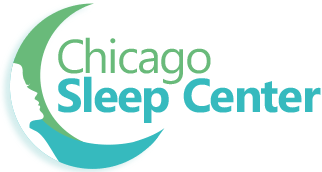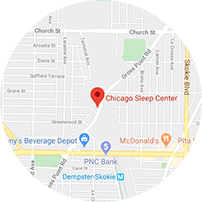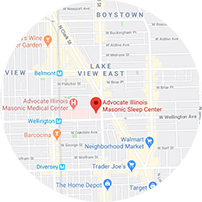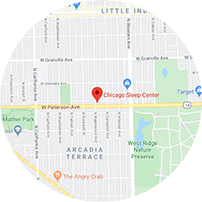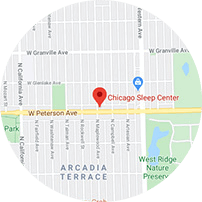CPAP

Continuous Positive Airway Pressure (CPAP) is the leading therapy for sleep apnea. Patients wear a face or nasal mask during sleep directing positive airflow into the throat and/or nasal passage to keep the airway open. Research shows that CPAP decreases daytime sleepiness, especially in those who have moderate to severe sleep apnea.
All of the CPAP units available through the Chicago Sleep Center offer lifetime wireless remote access to compliance data through ResMed Airview software. By activating remote monitoring, you can view and change therapy settings anywhere, anytime. This can reduce lengthy phone calls, unnecessary device returns, and unscheduled home visits.
Have you been recently diagnosed with obstructive sleep apnea? A CPAP machine is usually the first treatment prescribed for patients with obstructive sleep apnea (OSA).
Using a CPAP machine helps keeps airways open during sleep, improving both respiration and quality of sleep. At Chicago Sleep Center, we offer our patients CPAP units lifetime wireless remote access to compliance data through ResMed Airview software.
What is CPAP?
CPAP stands for Continuous Positive Airway Pressure. It’s a treatment for obstructive sleep apnea (OSA) and comes in the form of a machine and a tube that attaches to a breathing mask. It helps patients with OSA breathe while sleeping by making sure their airways stay open.
How Does a CPAP Machine Work?
A CPAP machine attaches to a mask that either goes over the nose and mouth or only the nose. Some devices may only link to prongs that fit directly into the nose.
There are three different kinds of CPAP machines available:
Nasal pillow mask
A nasal pillow mask is a CPAP machine that has a small cushion that covers the nostrils. It may also have prongs that fit into the nostrils.
With this kind of mask, you’ll be able to wear glasses with ease, and if you have lots of facial hair, a nasal pillow mask will still be able to fit securely on your face.
Nasal mask
A nasal mask is a CPAP machine that’s cushioned and covers the entire nose area. If you know that you move around a lot while sleeping, this may be a better option for you.
Nasal masks can deliver a high-pressure airstream.
Full mask
A full mask is a CPAP machine that’s triangle-shaped and covers both your nose and mouth. Your Chicago Sleep Center doctor may prescribe this kind of CPAP mask if you breathe through your mouth while sleeping or if you have a blockage in your nose.
CPAP machines deliver a constant supply of oxygen to your body while you’re sleeping. Continually providing oxygen prevents any interruptions to your breathing that sleep apnea causes.
Patients with OSA often snore and experience irregular breathing while sleeping because their tongue, soft palate, or other tissue surrounding the airway collapse and block the airway as their muscles relax.
The pressure applied by the CPAP machine forces air past these obstructions to keep the airway open. Patients with sleep apnea that use CPAP machines while sleeping allows for unobstructed breathing and more restful sleep. It’s the most common and is also usually the most effective form of sleep apnea treatment.
Do CPAP Machines Always Work for Sleep Apnea Patients?
CPAP machines work for most patients with obstructive sleep apnea. It can even save your life if you have severe sleep apnea by ensuring your airway doesn’t completely collapse while you sleep.
However, it doesn’t always work for everyone. Some patients find it challenging to use a CPAP machine, especially at first.
Sometimes issues are caused by not having the correct mask size or having trouble getting used to it. You can acclimate yourself by wearing it for short periods while awake.
You can also talk to your doctor at Chicago Sleep Center about adjusting the air pressure if it’s too high or attaching a humidifier to deal with an uncomfortable dry mouth.
Do you have sleep apnea? Contact the expert sleep specialists at Chicago Sleep Center in Chicago, IL, to find out more about CPAP machines and see if this treatment may be right for you!
CPAP Alternatives
Chicago Sleep Center offers a variety of alternative treatments to sleep apnea including oral appliances, Radiofrequency, Hypoglossal Nerve Stimulation treatment, and more. Be sure to inquire with your Chicago Sleep Center sleep expert to see which CPAP alternative treatment is right for you.
Oral Appliance Therapy
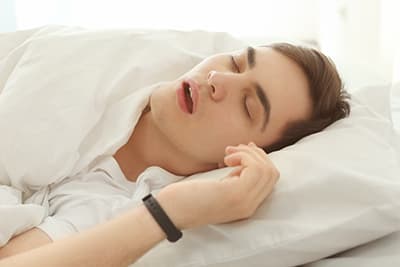
Oral appliance therapy is an effective treatment option for snoring and obstructive sleep apnea (OSA). A custom-fit oral sleep appliance can improve your sleep, restore your alertness, and revitalize your health. Worn only during sleep, an oral appliance fits like a sports mouthguard or an orthodontic retainer. It supports the jaw in a forward position to help maintain an open upper airway.
There are two important points to consider with oral appliances:
- Oral Appliance Therapy (OAT) is recommended by the American Academy of Sleep Medicine (AASM) as one of the first-line treatments for patients diagnosed with mild Obstructive Sleep Apnea (OSA). The AASM also recommends oral appliances for patients with moderate to severe OSA, who are unable to tolerate or cannot wear Continuous Positive Airway Pressure (CPAP) devices.
- Oral appliances are typically covered by medical insurance benefits but are not covered by dental insurance. Chicago Sleep Center is in-network with most insurances to cover oral appliance devices and oral appliance titration.
As a convenience to our patients, Chicago Sleep Center offers an on-site dentist for easy access to oral appliances.
TRIOS 5 Oral Scanner
The TRIOS 5 is a state-of-the-art technology that can be used in sleep medicine to enhance the treatment of sleep disorders. At Chicago Sleep Center, we utilize the TRIOS 5’s automatic bite registration capabilities to ensure the precise fitting of oral sleep appliances, leading to improved comfort and effectiveness in treating sleep-related issues.
What is the TRIOS 5?
The TRIOS 5 is a new and advanced technology developed by 3Shape, designed to revolutionize the process of viewing the intricate structures of the mouth, which can be helpful for sleep-related treatments and oral sleep appliances. At Chicago Sleep Center in Chicago, Illinois, our doctors utilize the TRIOS 5 scanner to provide accurate and detailed digital impressions, enhancing our ability to properly fit oral sleep appliances.

Using advanced optical technology, the handheld TRIOS 5 scanner captures precise 3D images of your teeth and surrounding tissues. This allows our doctors to examine your oral structures in exceptional detail, aiding in the diagnosis and treatment planning for sleep-related issues.
With its user-friendly and intuitive design, the TRIOS 5 scanner enhances the overall experience for both patients and doctors at Chicago Sleep Center.
What Are Some of the Key Features of the TRIOS 5?
The TRIOS 5 scanner utilizes advanced technology to capture detailed digital impressions of your teeth and oral structures. Here are some of the key features:
Optical Scanning
The TRIOS 5 scanner uses a sophisticated optical scanning system that projects a series of patterns onto your teeth and oral tissues. The scanner captures these patterns and analyzes the distortion to create a highly accurate 3D representation of your mouth.
Realistic Scan Colors
The TRIOS 5 scanner utilizes advanced technology to capture digital impressions with realistic colors. This innovative feature enhances the accuracy and lifelike representation of your teeth, allowing your doctor to visualize your oral structures with exceptional clarity.
The realistic scan colors provide a true-to-life representation, ensuring precise diagnostics and treatment planning.
ScanAssit
The TRIOS 5 scanner incorporates an advanced alignment technology called ScanAssist. This intelligent technology effortlessly builds up a precise 3D model of your teeth and oral structures during scanning.
How Does the TRIOS 5 Work?
A good night’s sleep is essential for a better quality of life, especially for individuals with sleep disorders and associated health conditions. To ensure effective and comfortable treatment, it is crucial to have an optimal fit for oral sleep appliances.
The TRIOS 5 allows for full-arch scanning and automatic bite registration, resulting in improved appliance fit and enhanced efficiency. With the TRIOS 5 scanner, scanning your teeth and oral structures becomes a breeze.
The scanner allows your doctor to scan in any direction, creating a customized scan path that works best for your specific needs. This flexibility ensures a smoother and more comfortable scanning process for you.
At Chicago Sleep Center, we understand the importance of maintaining your comfort and focus during the scanning process. That’s why the TRIOS 5 scanner uses haptics, a subtle vibration, to provide your doctor with helpful feedback.
This allows us to concentrate on scanning while ensuring your comfort throughout the procedure. The TRIOS 5 scanner device also doubles as a remote control.
This means that your doctor can conveniently navigate the 3D model on the screen without the need to touch external devices, such as a mouse. This enhances overall hygiene and reduces cross-contamination risks.
Do you want to learn more about the TRIOS 5? Schedule an appointment at Chicago Sleep Center in Chicago, IL, today!
The Pillar Implant
The Pillar Implant is a minimally invasive treatment option for mild to moderate palatal sleep apnea and snoring. The procedure places three tiny inserts in the patient’s soft palate, causing the palate to stiffen. The stiffening helps to prevent or lessen blockages of the airway—effectively treating sleep apnea and substantially reducing the severity of snoring in most individuals.
Pillar inserts are 18 mm in length and made from a woven soft polyester material that has been used for many years in implantable medical products. The Pillar Procedure is conducted in a single, short, in-office setting using local anesthetic and is completely reversible.
Office-Based Nasal Procedures
Our office-based nasal procedures include minimally invasive techniques to improve the nasal airway, such as the Nasal Valve Procedure and Radiofrequency Turbinate Reduction (RFTR).
RFTR is a minimally invasive surgical option that can reduce tissue volume in a precise, targeted manner. This technique uses radiofrequency to create lesions within the submucosal tissue of the turbinate, reducing tissue volume with minimal impact on surrounding tissues. RFTR differs fundamentally from traditional methods by using low-power radiofrequency energy to provide a relatively quick and painless procedure for tissue coagulation.
Radiofrequency
Radiofrequency is a minimally invasive, outpatient procedure that reduces and tightens excess tissue in the upper airway responsible for obstructive sleep apnea, including the base of tongue which is the most difficult to treat the source of the obstruction.
Over a period of three to eight weeks, the treated tissue is reabsorbed, leading to volume reduction and improved airway obstruction. The procedure itself typically takes 30 to 45 minutes, with only 2 to 4 minutes of actual energy delivery.
Behavior Modification
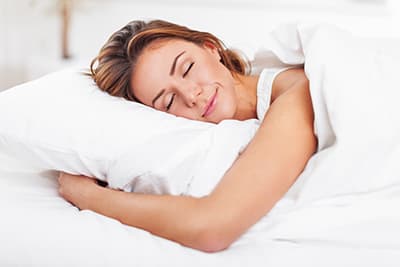
Behavior modification techniques or Cognitive Behavioral Therapy (CBT) are aimed at changing sleep habits and scheduling factors, as well as misconceptions about sleep and insomnia, that perpetuate sleep difficulties. In fact, the recent National Institute of Health state-of-the-science meeting on insomnia concluded that CBT is a safe and effective means of managing chronic insomnia and its effects.
If you don’t sleep well at night, it may be affecting your ability to get a good night’s sleep. You may think it’s simply part of life, but it could be a sign of a sleep disorder. Using behavior modification may be able to help you get an existing sleep disorder under control.
At Chicago Sleep Center, we’re dedicated to improving your sleep and health, getting you the rest you need.
What Behaviors Contribute to Sleeping Disorders?
Sleeping disorders can develop for a variety of reasons. Some of these reasons are physical, but sometimes they’re influenced by habits or emotional distress.
People who are sleep deprived, have an irregular sleep schedule, or are generally stressed are more prone to sleeping problems. Those predisposed to certain sleeping disorders due to genetics are more likely to have episodes under these conditions.
Not all sleeping disorders are influenced by behavior but changing your sleeping habits may still help ease symptoms and help you sleep better. It’s harder to get regular sleep if you’ve been sleep-deprived or have a hard time emotionally, even if you don’t have a sleeping disorder.
Changing your sleeping habits can be difficult, which is why there’s a way to get help.
How Can Cognitive Behavior Therapy Help with Sleeping Disorders?
Cognitive Behavior Therapy, or CBT, is a form of therapy practiced by a licensed mental health specialist. CBT can treat various psychological disorders, which can be helpful when underlying issues contribute to trouble sleeping.
At Chicago Sleep Center, our sleep specialists will be able to refer you to a CBT practitioner who specializes in treating insomnia. Insomnia can be a symptom of multiple sleeping disorders.
Your therapist will work with you to change your sleeping habits and teach you how to practice good sleep hygiene. They may ask you to keep a sleep journal to examine your habits and the quality of your sleep so you can both track your progress.
Your therapist will also help you work through any emotional issues that may be contributing to your sleeping problems.
What is Sleep Hygiene?
Sleep hygiene may be a term you’ve heard before when talking about sleeping habits. Sleep hygiene refers to everything you do surrounding sleep, including when you go to sleep, what you do before going to sleep, when you wake up, and anything else you do as part of your sleep routine.
Practicing good sleep hygiene is a great way to get more regular and restful sleep. Good sleep hygiene may vary from person to person, but the basics include:
- Going to bed at about the same time every night
- Waking up around the same time
- Not using electronics near bedtime
- Keeping the bedroom for sleeping only
Another part of sleep hygiene is how active you are during the day. Being more active during the day not only helps you stay healthy in general, but it will also help you feel more tired when it’s time to go to bed.
Good sleep hygiene also usually means having an established routine. This routine may involve doing something relaxing before bed, like reading or taking a bath. Different routines help different people, and what works for someone else may not work for you.
Our specialists and therapists can help you sleep better by working on your sleep hygiene. We’ll work with you to find the right kind of routine and give you the support you need to have an easier time sleeping.
Ready to sleep better? Schedule an appointment at Chicago Sleep Center in Chicago, IL, to learn more!
Cognitive-behavioral therapy for insomnia includes regular, often weekly, visits to a clinician, who will give the patient a series of sleep assessments, ask the patient to complete a sleep diary, and work with the patient in sessions to help change the way the patient sleeps.
CBT may also include Stimulus Control Instructions which are created by looking at the patient’s sleep habits and pinpointing different actions that may be prohibiting sleep. Additionally, the process is tailored to Sleep Hygiene Education, a customized list of things one should and should not do in order to sleep.
 Back to Top
Back to Top
Surgical Options
In the event that more conservative treatments have failed, surgical techniques to alleviate airway obstruction are often straightforward and effective.
Inspire Sleep Apnea Therapy
Do you have sleep apnea? Do you find yourself tired during the day and unable to get a good night’s sleep even with a CPAP machine?
Looking for an alternative treatment in the Chicago area? Inspire may be the treatment that you need.
Inspire is an implantable device designed to help patients with Obstructive Sleep Apnea (OSA) who haven’t found relief using a CPAP machine. There are many OSA patients who can benefit from Inspire. Chicago Sleep Center is now offering this therapy option for patients with sleep apnea.
How Does Inspire Work?
Inspire is a small device that’s implanted in the body. This occurs during a minimally invasive, two-hour outpatient procedure.
The device is designed to stimulate your hypoglossal nerve. The hypoglossal nerve is the nerve in your body that controls the tongue’s muscle movements.
OSA often develops as a result of the tongue blocking the airway while you’re asleep. Inspire sends a gentle electrical impulse through the hypoglossal nerve. This signals the tongue to move out of the way each time you draw a breath.
The device is implanted at three points right under the skin. The main device is first implanted on the upper chest.
This is then connected to a sensor placed on the lower chest and one placed under the chin where your hypoglossal nerve is located. After implanting the device, it’s controlled by a remote that’s used to turn it on before you go to sleep.
Is Inspire Right for Me?
Before you can undergo Inspire sleep apnea therapy, you first need to be officially diagnosed during a full sleep study. After receiving an OSA diagnosis, you’ll discuss treatment options with your doctor.
At this point, your doctor can then determine if you may be a potential candidate for Inspire. There are a few key factors that could indicate you may be a good candidate, including:
- You have moderate to severe obstructive sleep apnea
- You are unable to use or get consistent benefit from CPAP
- You are not significantly obese
- You are age 18 or above
If your doctor thinks you may be a candidate for Inspire, you’ll then need to have an airway exam. This is an exam conducted through a drug-induced sleep endoscopy or DISE.
The airway exam is a very routine and non-surgical exam. You are given a short-acting medication to put you to sleep. While you’re asleep, a camera records how your airway opens and closes. The whole exam takes about 20 minutes, and when you’re done, you’ll find out if Inspire is right for you!
What is Sleeping with Inspire Like?

After having Inspire implanted, using it is simple. You turn it on with a remote before you go to sleep.
When you’re awake during the day, the device is never turned on so you don’t feel anything the majority of the time. When the device is on, it sends gentle impulses t
hat make sure your tongue moves forward whenever you take a breath to keep your airway unobstructed.
This pulse stimulates your motor functions rather than any sensory nerves. It isn’t something you feel in the same way you would feel a touch or a pinch.
While the device is on, patients do report feeling this pulse before they fall asleep but the majority don’t find it bothers them. With Inspire making sure your airway remains unobstructed, you’ll be able to get a full night’s sleep.
Wondering if Inspire may be right for your sleep apnea needs? Contact Chicago Sleep Center to request more information!
WatchPAT Sleep Apnea Test
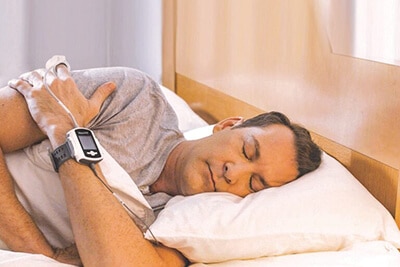
We are proud to now offer the WatchPAT Sleep Apnea Test by Itamar Medical! Unlike traditional Sleep Apnea testing, where patients have to stay at a testing facility, WatchPAT can be used from the comfort of your own home! The device is simple, reliable, and is the first fully disposable sleep apnea test!
How does it work?
WatchPAT is like a smartwatch and is worn on the wrist with a finger probe that goes onto the pointer finger. The probe applies uniform pressure, which enables optimal signal quality, and precise measurements. WatchPAT is able to classify the different sleep stages and the wrist actigraph differentiates when you are asleep, or awake!
WatchPAT connects to your smartphone to collect and send results through a secure server to your sleep physician. Your sleep physician can then read and interpret the results to determine if you have Sleep Apnea, and prescribe the appropriate treatment option. WatchPAT is disposable, so there is no need to return the device!
Sinus Surgical Procedures
If you have difficulty breathing or suffer from chronic sinusitis, you may need a sinus surgical procedure to restore your nasal function. Chicago Sleep Center performs many sinus surgical procedures to help patients improve their breathing and regain their quality of life.
Balloon Sinuplasty
Balloon Sinuplasty is a minimally invasive procedure that treats patients with chronic sinusitis. The procedure inserts a thin, flexible balloon catheter into your sinus openings.
After inserting the balloon catheter into the sinus openings, it inflates, expanding the sinus passageways. Inflating the balloon and expanding the sinus passageways widens any blocked or narrowed sinuses, providing you with improved drainage and ventilation and relief from frustrating sinus symptoms like constant congestion.
Who is a Good Candidate for Balloon Sinuplasty?
Balloon Sinuplasty is best for patients with chronic sinusitis who have tried other treatments, like nasal corticosteroids and antibiotics, without seeing any improvement. You may also be a good candidate for Balloon Sinuplasty if you suffer from recurrent sinus infections, persistent facial pain, pressure, or sinus blockages.
What to Expect with Balloon Sinuplasty Recovery
Balloon Sinuplasty is typically performed under general or local anesthesia to keep patients comfortable. After Balloon Sinuplasty, patients can resume their usual routine after a day or two.
You may be congested, notice drainage from your nose, or have pressure in your face for a few days. However, recovering from Balloon Sinuplasty is much shorter and more comfortable than other sinus procedures.
VivAer
VivAer is an advanced procedure offering targeted and non-surgical treatment for patients with nasal airway obstruction. VivAer uses radiofrequency energy to remodel and reshape tissues in the nose.
Remodeling and reshaping tissues in the nose improve airflow in patients. Doing this also reduces symptoms caused by nasal obstruction.
Who is a Good Candidate for VivAer?
You may be a good candidate for VivAer if you’re experiencing congestion or finding breathing challenging due to structural issues in your nasal airway. These include:
A deviated septum
Nasal valve collapse
Turbinate hypertrophy
You may also be a good fit for VivAer if you suffer from chronic congestion but don’t want to undergo an invasive surgical procedure to treat it.
What to Expect with Recovery from VivAer
VivAer is an outpatient procedure, meaning you can go home the same day after it’s over. VivAer takes about 15-20 minutes to perform.
Your ENT specialist at Chicago Sleep Center will use local anesthesia to perform VivAer to keep you as comfortable as possible. Once you get home, you can resume your usual routine and activities.
You may notice some temporary congestion, nasal discomfort, or mild bleeding, but these side effects should dissipate and go away within a few days as you heal from having VivAer.
SINUVA
SINUVA is a revolutionary sinus implant that relieves patients of recurrent nasal polyps. The implant has a steroid-releasing spring that expands in your sinus cavity.
When the spring expands in your sinus cavity, it delivers anti-inflammatory medication directly to the area affected by nasal polyps.
Who is a Good Candidate for SINUVA?
Although SINUVA is a fantastic way of treating nasal polyps, it is unsuitable for all patients. You may be a good candidate for SINUVA if you’re 18 or older, have had previous sinus surgery, and still experience recurring nasal polyps.
It’s suitable for patients with nasal polyps obstructing their sinuses. When nasal polyps block the sinuses, they may cause ongoing symptoms like loss of smell, pressure in the face, or congestion.
What to Expect with Recovering after SINUVA
Having SINUVA placed in your nose is a quick, in-office procedure. Your ENT specialist at Chicago Sleep Center will use local anesthesia to numb the area and insert the implant into your nasal cavity.
After SINUVA, you can return to your usual routine within a day or two. You may notice side effects like congestion, mild discomfort, or minor bleeding, but these should improve and stop within a week.
Sinus Surgery
Sinus surgery, or functional endoscopic sinus surgery (FESS), is a surgical procedure that corrects structural abnormalities or severe sinus conditions that don’t respond to less invasive treatments. It uses an endoscope to access and remove obstructions while improving drainage function from the sinuses.
Who is a Good Candidate for Sinus Surgery?
You may be a good candidate for sinus surgery if you have issues like the following:
Nasal polyps
Sinus tumors
Chronic sinusitis
Structural abnormalities that affect the sinuses
Sinus surgery is usually recommended if other treatments have been tried and haven’t relieved these conditions.
What to Expect from Recovery from Sinus Surgery
Sinus surgery is performed under general anesthesia and may be an in or outpatient, depending on the complexity needed. Most patients can resume their normal activities within one to two weeks of sinus surgery.
You may experience nasal congestion, drainage, and mild pain as you recover and heal, but these should improve over time. You’ll likely need to use nasal rinses and pain medication to ensure proper healing and will attend follow-up appointments.
Chemical Nasal Cautery
If you have recurrent nosebleeds, you may need chemical nasal cautery or silver nitrate cautery. The procedure applies a chemical agent where bleeding in the nose takes place. Doing this promotes blood vessel constriction and clotting.
Who is a Good Candidate for Chemical Nasal Cautery?
You may be a good candidate for chemical nasal cautery if you have frequent nosebleeds due to having delicate blood vessels in the nose. You may also be a good fit for the procedure if you have medical conditions like hereditary hemorrhagic telangiectasia (HHT).
What to Expect from Recovery from Chemical Nasal Cautery
Chemical nasal cautery is often performed as an outpatient procedure. Most patients can return to their daily activities immediately after without a lengthy recovery period. Occasionally, you may experience mild discomfort or congestion, but these usually go away quickly.
Are you suffering from sinus conditions that make it hard to breathe? Find out if sinus surgery may be a good fit for you by scheduling your appointment at Chicago Sleep Center in Chicago, IL, today!

